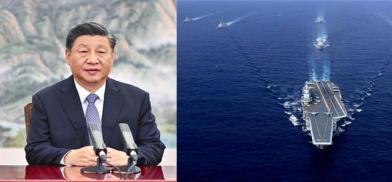Xi’s endgame and strategic power manoeuvres: Prospects of regional instability loom
In preserving its strategy of breaking the containment policy, Moscow, Tehran, Islamabad, Taipei and Pyongyang remain at the forefront. All five will be used as a bargaining tool with Washington and the containing squad in exerting greater influence and say on the pull-push tussle in the Indo-Pacific domain, writes Collins Chong Yew Keat for South Asia Monitor

For as much as the war in Ukraine caused unprecedented reverberations across the globe in the disruptive economic fallout and the triggering of further escalatory security dilemmas, the ultimate bigger picture of the threat spectrum remains the Indo-Pacific quagmire, at least from the lenses of Washington.
The recent high-profile call between President Joe Biden and President Xi Jinping that highlighted defiant stands by both only reinforces conventional perspective that the path is set towards a century of a prolonged and sustained adversarial-based relationship, with constant chessboard manoeuvring of containment and countermeasures. Taiwan remains the pinnacle of Beijing’s interests and the ultimate red line, something Washington will be more than ready to use for its long-term strategic calculations.
In upping the ante and in showcasing greater chips and cards, the pass-by of the Shandong aircraft carrier in the Taiwan Strait just hours before the official call kicked in did not alter much of the predicted outcome, that the Beijing-Washington relationship remains rooted in cost-benefit calculations in securing survival and pride than even the personal build-up of understanding between Biden and Xi years before could provide reprieve, if any.
Both sides will not waver in their positions, both for explicit and implicit reasons. This involves greater domino implications and in fulfilling internal demands at home. Critics have pointed out the different effects and policy impact, whether seen as more effective and hawkish or otherwise should the presidency be different. It is not a battle of personas and comradeships, it is the ultimate tragedy and impact of great power politics and competition, with the need to contain a rising power and the need for the rising power to escape from the subjugation at all costs. A Democrat or a Republican in the presidency will not waver the rock-solid direction that Washington has to take in dealing with China, which is systemically, structurally and realistically driven.
US-China ties
Warnings of destructive sanctions that might ensue for Beijing if it kowtows to Moscow’s plea for military and economic lifelines seem to be insufficient for Xi to tip the balance of long-term calculations for Beijing’s interests. For as much as Moscow is desperate for Beijing’s favour, it works in a vice versa sphere as well, with Beijing’s strategic calculations for Russia to remain its biggest, easiest and nearest support in the risks of an escalatory containment stand by Washington or to ward off threats from the Quad and the 5-4-3-2 containment structured as claimed by Beijing.
Besides serving as the perfect barrier to the North and to the West of China, as the barrier from potential offensive capacities from the Arctic, Moscow will continue maintaining its grip and hold on Central Asian states to ward off any links and routes of containment and penetration from the Western side. Its southern grip is mainly Beijing’s to lose for now, and this left its eastern as the ever most persistent and sustained threat from Washington and Tokyo, even Seoul to a larger extent.
Other potential linkages of support are geographically misaligned and with other chain risks of entangling too deeply while the Middle East and Africa are being banked largely for energy security for now, at least in the near term. Russia not only remains pivotal in the military security domain, with long-term importance in the projection of food and energy security. Escalating impact of climate change will render Moscow to be the long-term benefactor in unlocking hidden potential and opportunities for enhancing food production and agricultural sustainability to a higher strategic level, particularly the opening up of the vast Siberian mass, at a time where diminishing and even devastating prospects and outcomes will be seen elsewhere and more damagingly in China.
In preserving its strategy of breaking the containment policy, Moscow, Tehran, Islamabad, Taipei and Pyongyang remain at the forefront. All five will be used as a bargaining tool with Washington and the containing squad in exerting greater influence and say on the pull-push tussle in the Indo-Pacific domain, with greater implications on Western strategy and in continuing the divide and rule approach. Conventional strategy in maintaining usage of economic wielding power in reaping the phased returns from the states beholden to this lifeline both economically and politically will ensure a controlled hindering push against being engulfed with the Western pull.
China and Russia
For the entire spectrum of strategic cost-benefit calculations, Xi is well poised to continue to push for closer integration with Moscow albeit realizing the immediate fall-out Beijing will have to endure with the no prisoners taken stand taken by Washington in pushing for greater leverage in getting Beijing to play its part. The remaining chessboard maneuvering that comes into the picture is the extent of sacrifice and resilience for Beijing and for Xi personally to weather the direct implications of the eventual sanctions exerted by Washington should Xi be adamant in sticking to Moscow.
In this tricky situation, Xi is trapped by the confinement of time in securing the capacities needed to minimize the fall-out both on China’s already stagnating and declining economic prospect and in managing internal social unrest and the divide that will ensue.
The timing has not been positive, with this year being a crucial push for Xi in securing an unprecedented third term and paving the path for permanent presidency in the Chinese Communist Party 20th Congress come fall. His Great Rejuvenation mantra and the need to strengthen his grip and policy adherence in ensuring the internal gaps and weaknesses will not pose a major stumbling block to the bigger vision of the Chinese Dream of 2049.
If push comes to shove, Xi is projected to still maintain the greater foresight of tolerating initial pain and drains for the battle while preserving the edge in winning the war in the long term. Moscow will remain on the radar of strategic importance for Beijing, simultaneously maintaining a close eye on swift adjustments to the No Limits policy whenever imminent interests are threatened. Past testy ties and a history of the war between the two will forever be ingrained in the calculated moves by each side, with more to lose for Beijing if it continues to withstand the solidified global push against Moscow and the reluctance to join the bandwagon.
Xi feels heat
Increasingly Xi feels the heightened pressure and most importantly, the weight of the burden it has to bear in justifying the continued siding with Putin in light of the sustained revelations of serious war crimes committed and the systematic violations of order and norms with an increasingly unhinged backlash from the rest of the world. If the fulcrum of cost-benefit calculations increasingly tilts towards a greater unsalvageable liability, Xi will have further capacities and options on his arsenal to deny the piggyback ride by Putin.
While Beijing is entering the strategic ambiguity phase of its ties with Moscow, Washington is increasingly keen to move out from it with its engagement with Taiwan. Xi certainly does not have time on his side with his drawboard on Taipei, with each day passing by presenting a more difficult position for Beijing to exert forceful unification, at least from Washington's point of view. Both sides understood the entirely different stakes at play for Taiwan and there is little hope for de-escalation in each other’s intention to commit. While Washington realizes this remains Beijing’s no hold barred red line, the stakes are too high to bear with the prized semiconductor dominance, the ease of power projection to the Pacific and the domino fallout of the emboldened move in the wider regional setting providing a systematic and irreversible end game for American countermeasures.
Xi is keen to capitalize on the short window period he still enjoys now, maximizing on the high public sentiment of resolving the Taiwan conundrum for good and fulfilling his personal wish in cementing his legacy as the figure who finally brought back Taiwan. With American naval power and resilience being perceived to be at the weakest link in decades and an expansionary upgrade in offensive totality not on offer until the fruition of Battle Force 2045 started by then-President Trump, Beijing is tempted to find the best strategic timing either in the period leading to the Congress or in the immediate cementing of Xi’s position after the Congress, both serving as the booster and in heralding of a new era ahead of Xi’s continual ambitious rejuvenation plan.
This comes with great risks, however, with the momentum on the side of the West with its galvanized front and consolidation of greater solidarity in defending the pillars of freedom and democracy, further bolstered by the momentum and wielding of economic and financial costs to those keen to break the norms and orders. In China’s case, this does not constitute a violation of the established order as Taiwan has long been stated as an internal affair, with no compromise on its stand come what stakes or sacrifices there might be, at least from Xi’s rationale. It will be less of a concealed guessing game from now on, with conventional dogmas and domains of the past failing to produce intended results. With frustrations and impatience risking further miscalculations, Washington is further compelled to urgently fortify its naval deterrence and to prevent Beijing’s increasingly solid anti-access/area denial capacities (A2/AD).
US and allies
Washington realizes it will need the inclusion of its allies in the Indo-Pacific region with their committed support, hoping that the lessons of Ukraine and the escalating assertiveness of Beijing serve as the pushing factors for them to solidify their leanings on the West. As much as mind games and brilliant strategic manoeuvres and gameplays have managed to preserve the previous status quo, the Kremlin’s move on Ukraine lays to rest conventional defensive and offensive postures of actors in the region, opening the floodgates for the vicious cycle of the arms race, escalating security dilemma implications and regional instability.
It will take more than a dialogue in the UN Security Council or conventional confidence-building measures in the archaic model of conflict resolution to prevent further deterioration. It boils down to basic dissection and interpretation of the paradigms and paradoxes of existing theories and peripheries, whether states are better off cooperating for peace, prosperity and positivity or being at war for power, pride and plutonium. Events over the past months certainly favour the triumphant return of a realist explanation of events, opening the floodgates for greater responses to the ever-pertinent security dilemma and the inevitable global arms race.
(The author is a strategic and security analyst who has been with the University of Malaya for more than nine years. Views are personal. He can be contacted at collins@um.edu.my)










Post a Comment